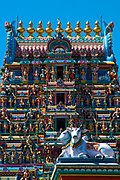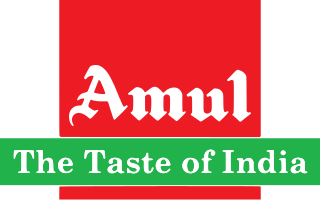
Amul is an acronym of the Indian Multinational cooperative society named Gujarat Milk Marketing Federation based in Anand, Gujarat. It is under the ownership of Gujarat Cooperative Milk Marketing Federation Limited, Department of Cooperation, Government of Gujarat. It is controlled by 3.6 million milk producers.

Verghese Kurien was an Indian dairy engineer and social entrepreneur who led initiatives that contributed to the extensive increase in milk production termed the White Revolution.

Anand is the administrative centre of Anand District in the state of Gujarat, India. It is administered by Anand Municipal Corporation. It is part of the region known as Charotar, consisting of Anand and Kheda districts.

The National Dairy Development Board (NDDB) is a statutory body set up by an Act of the Parliament of India and an Institution of National Importance. It is under the ownership of the Ministry of Fisheries, Animal Husbandry and Dairying of the Government of India. The main office is in Anand, Gujarat with regional offices throughout the country. NDDB's subsidiaries include Indian Dairy Machinery Company Ltd (IDMC), Mother Dairy and Indian Immunologicals Limited, Hyderabad, NDDB Dairy Services, NDDB Mrida Ltd., NDDB CALF Ltd. The Board was created to finance and support producer-owned and controlled organisations. Its programmes and activities seek to strengthen farmer cooperatives and support national policies that are favourable to the growth of such institutions. Cooperative principles and cooperative strategies are fundamental to the board's efforts.
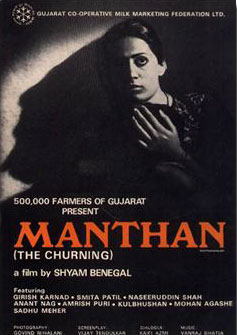
Manthan, also released under the translated title The Churning, is a 1976 Hindi film directed by Shyam Benegal, inspired by the pioneering milk cooperative movement of Verghese Kurien, and is written jointly by him and Vijay Tendulkar. It is set amidst the backdrop of the White Revolution of India. Aside from the great measurable success that this project was, it also demonstrated the power of "collective might" as it was entirely crowdfunded by 500,000 farmers who donated Rs. 2 each. Manthan is the first crowdfunded Indian film.
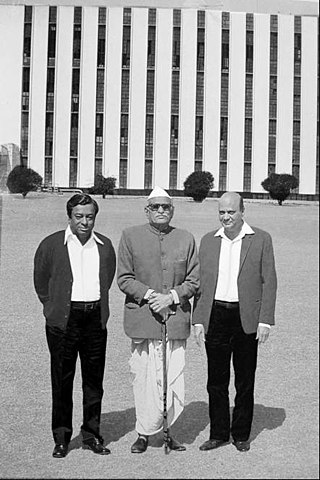
White Revolution or Operation Flood, launched on 13 January 1970, was the world's largest dairy development program and a landmark project of India's National Dairy Development Board (NDDB). It transformed India from a milk-deficient nation into the world's largest milk producer, surpassing the United States in 1998 with about 22.29 percent of global output in 2018. Within 30 years, it doubled the milk available per person in India and made dairy farming India's largest self-sustainable rural employment generator. The program was launched to help farmers direct their own development, and to give them control of the resources they create.

Tribhuvandas Kishibhai Patel was an Indian independence activist, lawyer, and politician. A follower of Mahatma Gandhi, he is regarded as the father of the cooperative movement in India, most notably in the Kaira District Co-operative Milk Producers' Union in 1946, and the Anand Co-operative movement.
In Sri Lanka many farmers depend on animal husbandry for their livelihood, but not a large proportion. Therefore, many livestock products have to be imported. The main livestock products in Sri Lanka are milk, meat and eggs. Hides, wools and other products are still not produced within the country. Animal power formerly used in the cultivation of rice and vegetables have been replaced by modern technology to farmlands. However animal husbandry plays an important role in the rural economy for improving the living conditions of farmers in the country.

Amrita Patel is an Indian businessperson associated with cooperative dairy sector as well as environmentalist. She headed National Dairy Development Board from 1998 to 2014 which led the world's biggest dairy development program Operation Flood. She chaired several other institutes and has been a member of board of banks. She was awarded Padma Bhushan in 2001.

Being a country that has a largely rural and agriculture-based industry, animal husbandry plays an important role in the economy of Pakistan and is a major source of livelihood for many farmers. It is estimated that there are between 30 and 35 million people in Pakistan's current labour force who are engaged in livestocks. While the agricultural practice is prevalent throughout the entire country, it is more common in the fertile provinces of Punjab and Sindh, which are traditionally the main areas of agriculture and farming activity. In 2020, the livestock industry was contributing 60.6 % to overall agriculture and 11.7 % to the GDP.

The Department of Animal Husbandry, Dairying and Fisheries is one of the departments of Government of Tamil Nadu. The departments encompasses the departments of animal husbandry, fisheries, milk production and dairying.
The cooperative movement in India plays a crucial role in the agricultural sector, banking and housing. The history of cooperatives in India is more than a hundred years old. Cooperatives developed very rapidly after Indian independence. According to an estimate, more than half a million cooperative societies are active in the country. Many cooperative societies, particularly in rural areas, increase political participation and are used as a stepping stone by aspiring politicians.
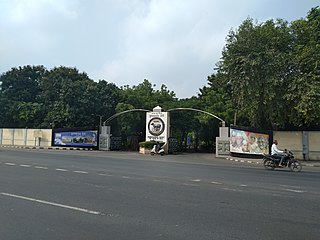
The Mehsana District Cooperative Milk Producers' Union Limited, popularly known as Dudhsagar Dairy, is a division of Gujarat Cooperative Milk Marketing Federation which is under the ownership of Ministry of Cooperation of the Government of Gujarat.

Banas Dairy is a division of Gujarat Cooperative Milk Marketing Federation which is under the ownership of Ministry of Cooperation, Government of Gujarat based in the Banaskantha district of Gujarat, India and is Asia's largest milk producer. It was founded in 1969, in accordance with the 1961 rule of the National Dairy Development Board under Operation Flood. Galbabhai Nanjibhai Patel played an important role in the foundation of the dairy. It is headquartered at Palanpur.
Dara Nusserwanji Khurody was an Indian entrepreneur known for his contributions to the dairy industry of India. He worked in various private and government organization at the start of his career and also held government official positions later on. He was the Milk Commissioner of Bombay from 1946 to 1952. His name was considered "synonymous with dairying" in India in the 1950s. He received the Ramon Magsaysay Award jointly with Verghese Kurien and Tribhuvandas Kishibhai Patel in 1963 and the Padma Bhushan from the Government of India in 1964.
Central Institute for Research on Buffaloes, Hisar, a publicly funded, institute for water buffalo research. It is located 170 kilometres (110 mi) from Delhi, at Hisar in the north Indian state of Haryana. It has a sub-campus, Bir Dosanjh, at Nabha. CIRB operates a nationwide network of 10 research centres working on breed improvement of the 7 main native breeds. CIRB, with over 20 laboratories for buffalo research, is the world's largest buffalo research institute with the widest range of breeds under study. With the aim of improving breeds and dissemination of information, CIRB has sold over 1,000 bulls, conducted ~200,000 artificial insemination in the field for the farmers' buffaloes with a 41% conception rate, distributed ~520,000 progeny tested frozen semen kits to 45,000 farmers and over 250 institutes, imparted training to several thousand farmers on advanced buffalo husbandry, and created the world's first online Buffalopedia in several languages. It has a large research partner network across India and the globe. It is the second institute to successfully clone a buffalo in 2016, after the first successful cloning was achieved by the National Dairy Research Institute, Karnal in 2010. In July 2017, the Indian Council of Agricultural Research ranked CIRB Hisar as India's number one Buffalo research institute for the year 2016–17.
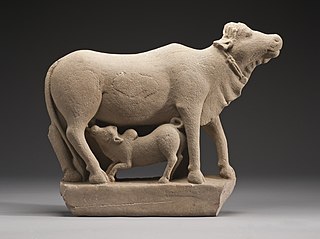
Dairy plays a significant part in numerous aspects of Indian society, including cuisine, religion, culture, and the economy.
The Department of Animal husbandry and Dairying (DAHD) is an Indian government department. It is a subsidiary department of the Ministry of Animal Husbandry, Dairying and Fisheries which was formed as a new Indian ministry in 2019. The DAHD or the erstwhile Department of Animal husbandry, Fishiries and Dairying was formed in 1991 by merging together into a separate department, of two divisions of Department of Agriculture and Cooperation, namely animal husbandry and dairy development.In 1997 the fishiries division of Department of Agriculture and Cooperation and a part of the Ministry of Food Processing Industries was transferred to it. In February 2019 the Department of Fisheries was carved out from the Department of Animal husbandry, Dairying and Fisheries and it has been functioning as Department of Animal Husbandry and Dairying since then.

Harichand Megha Dalaya was the inventor of the first spray-dryer for buffalo milk in the world. His invention revolutionized India's dairy farming industry and laid the foundation for Amul cooperative's immense success.
Jayen Mehta is an Indian business executive. He serves as the managing director at the Gujarat Co-operative Milk Marketing Federation Ltd (GCMMF), the largest food product marketing organization in India and a state government-owned cooperative society, known for its brand Amul. Prior to this, Mehta held the position of Chief Operating Officer of Amul.
